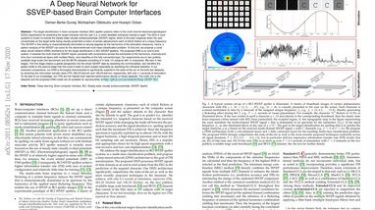A Deep Neural Network for SSVEP-based Brain Computer Interfaces

The target identification in brain-computer interface (BCI) speller systems refers to the multi-channel electroencephalogram (EEG) classification for predicting the target character that the user intends to spell. The EEG in such systems is known to include the steady-state visually evoked potentials (SSVEP) signal, which is the brain response when the user concentrates on the target while being visually presented a matrix of certain alphanumeric each of which flickers at a unique frequency...
The SSVEP in this setting is characteristically dominated at varying degrees by the harmonics of the stimulation frequency; hence, a pattern analysis of the